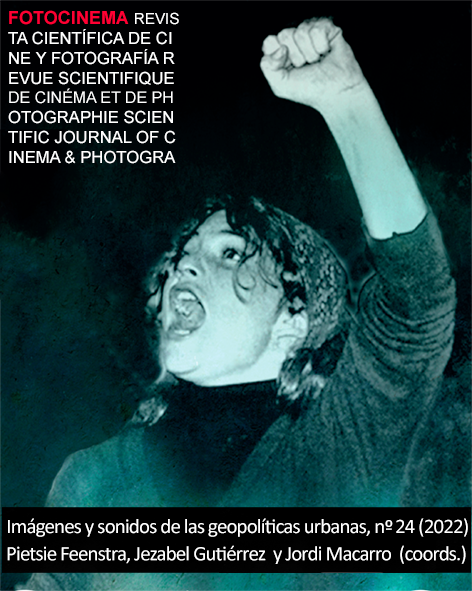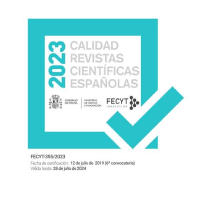Stretching the cord: Autobiographical documentary and maternal bond in Stories we tell, Hija, Amazona and Look at us now, mother!
DOI:
https://doi.org/10.24310/Fotocinema.2022.vi24.13731Keywords:
Autobiographical documentary, Documemoir, Attachment, MaternityAbstract
This text reviews the films Historias que contamos (2012, Stories we tell, Sarah Polley), Hija (2012, María Paz González) Amazona (2017, Clare Weistkopf) and Portrait of my mother (2016, Look at us now, mother! Gayle Kirschenbaum) from the resources and methodologies proper to the autobiographical documentary, its entity as research within the subtype documemoir, from the narratives of the types of attachment of social psychology and from its contribution to deactivate the idealization of motherhood as a patriarchal myth in conflict with the heterogeneous real motherhood. These examples make use of the interview, the real or recreated home movies, the road-movie, the filmed travel diary demonstrating their belonging to the participatory and reflexive subtypes. They share the subjectivity, personal temporality and performativity of memory films. The comprehensiveness of their collaborative proximal autobiography allows them to address the bond with their reference attachment figure, their mother, explaining the secure and insecure preoccupied attachment styles they have developed in dealing with them. The documemoir subtype thus proves to be a suitable container for addressing motherhood and freeing it from the narrow patriarchal narratives of its idealization inherited from the 1990s towards narratives of real motherhood.
Downloads
Metrics
References
Akerman, Ch. (2015) No home movie. Bélgica-Alemania: Liaison Cinématographique, Paradise Films
Altschiller, D. (2005). A Dog´s Life: a Dogamentary review. Library Journal, 130 (20), 181-2.
Anderson, Carolyn. (2020, diciembre 8) Autobiography and documentary in Aitken Ian. (2005) Encyclopedia of Documentary Film. Routledge. http://cw.routledge.com/ref/documentary/autobiography.html
Benning, S. (1989). Living inside. EE.UU: Sadie Benning.
Berliner, A. (1994). Nobody´s business. EE.UU: Cine-Matrix, Independent Television Service.
Brakhage, S. (1959) Window, water, baby moving. EE.UU: Stan Brakhage.
Citron, M. (1978). Daughter Rite. EE.UU: Iris Films.
Coixet, I. (2005) La vida secreta de las palabras. España: El Deseo, Mediapro.
Coixet, I. (2003) Mi vida sin mí. España-Canadá: El Deseo, Milestone Entertainment, Antena 3 Televisión, Vía Digital.
Colectivo Miope. (2011) Entrevista a María Paz González. HIJA o “todos desde O´Higgins”. CineChile Enciclopedia del Cine Chileno. Recuperado de: http://cinechile.cl/entrevistas/entrevista-a-maria-paz-gonzalez-hija-o-todos-desde-ohiggins/
Cuevas, E. (2003). Imágenes familiares: del cine doméstico al diario cinematográfico. Archivos de la filmoteca: revista de estudios históricos sobre la imagen, 45, 128-140.
Chopra, J. (1972) Joyce at 34. EE.UU: Phoenix Films.
Deren, M. Hammid, A. (1943) Meshes of the afternoon. EE.UU: Maya Deren Experimental Films.
Ding, L. (2014) Some conceptual concerns in producing Ancestors in the Americas. Center for Educational Telecommunications. Recuperada de: http://www.cetel.org/docu.html
Del Rincón, M. Torregrosa, M. Cuevas, E. (2017) La representación fílmica de la memoria personal: las películas de memoria. ZER, 22 (42), pp. 175-188. DOI: 10.1387/zer.17842
Donoso, C. (2018) Estrategias del desexilio: la marca de los objetos en la construcción de un relato común, Estudios Avanzados, 28, pp. 34-55. https://repositorio.uchile.cl/handle/2250/152676
Douglas, S. J. Michaels, M. W. (2004) The Mommy myth. The Idealization of Motherhood and how it has undermined women. New York. Free Press. Edición de Kindle.
Eakin, P. J. (1999). How Our Lives Become Stories: Making Selves. Ithaca: Cornell University Press citado en LAGOS, P. (2011). Ecografías del “Yo”: documental autobiográfico y estrategias de (auto)representación de la subjetividad. Comunicación y Medios, 24, 60-80.
Erens, P. (1975) Making and Distributing Nana, Mom and me. Feminist Art Journal. Vol, 4 (2). Recuperado de: https://www.jstor.org/stable/pdf/community.28036291.pdf
Fuentes, M.; Yearian, B. (1995). Bontoc Eulogy. EEUU: Marlon Fuentes.
Gerrie, A. (15 de noviembre de 2015). Gayle Kirschenbaum: Filmaker tells of life with the mother from hell. Independent. https://www.independent.co.uk/arts-entertainment/films/features/gayle-kirschenbaum-filmmaker-behind-documentary-look-us-now-mother-why-she-made-film-about-growing-abusive-parent-a6735201.html
González, María Paz (2011). Hija. Chile: Maria una vez. Blume (Chile), Panchito Films (Chile), Carapulkra Films (Perú).
Hoffmann, D. (1994) Complaints of a Dutiful daughter. EE.UU: Jan Miller Corran & Deborah Hoffmann.
Kirschenbaum, G. (2004). A dog´s life: a dogamentary. Gayle Kirschenbaum.
Kirschenbaum, G. (2016). Look at us now, mother! Kirschenbaum Productions.
Lagos, P. (2011). Ecografías del “Yo”: documental autobiográfico y estrategias de (auto)representación de la subjetividad. Comunicación y Medios, 24, 60-80. DOI: 10.5354/0719-1529.2012.19894
Landertinger, J. (2016) Home, el país de la ilusión. Colombia-Portugal: Josephine Landertinger, Pedro Neves, Edward Poveda, Tomás Poveda, Solangel Rios.
Lejeune, P. (2008). Cine y Autobiografía, problemas de vocabulario. En Martín gutiérrez, G. (ed). Cineastas frente al espejo. (pp. 13-26). Madrid: T&B Ediciones.
Llanos, B. (2016) Políticas del afecto y memoria política en el documental de la segunda generación de Argentina y Chile, Nuestra América, 10 (15), 221-229. DOI: 10.47195/PM16
Malatesta, C.Z. & Wilson, A (1988) Emotion cognition interaction in personality development: A discrete emotions funtionally analysis. British journal of social Psychology, 27, 91-112. DOI: 10.1111/j.2044-8309.1988.tb00807.x
Mallet, M. (1982) Journal inachevé, vision subjective de l’exil. Canadá: Coproducción Canadá-Chile.
Mekas, J. (1969) Walden: Diaries notes and sketches. EE.UU: Filmmakers Distribution Center.
Mendoza, D. Y. (2017) Cine Experimental y Documental Personal: Directores y Directoras que resignifican su yo a través del Cine. Wimblu, 12 (2), 43-65. http://dx.doi.org/10.15517/wl.v12i2.31489.
Merás, L. (2021). El vínculo mortal. La relación madre-hija en Quién te cantará (Carlos Vermut, 2018). Fotocinema: revista científica de cine y fotografía, 22. 373-396. Doi: 10.24310/Fotocinema.2021.vi22.11736
Moffatt,T. (1990) Night cries: a rural tragedy. Australia: The Australian Film Commission.
Nichols, B. (2001). Introduction to Documentary. Bloomington. Indiana University Press.
Ozeki, R.L. Ozeki, R. (1996) Halving the bones. Japón: Sara Diamond.
Perizonius, M., (2004). Communekind). Holanda: Lemming Film
Nederlandse Christelijke Radio-Vereniging (NCRV)
Perry, F. (1981). Mommie dearest. EE. UU: Paramount Pictures.
Pinto, I. (2012). Entrevista a María Paz González, La Fuga, 13. Recuperado de: http://2016.lafuga.cl/entrevista-a-maria-paz-gonzalez/521
Polley, S. (2007) Away from her. Canadá: Foundry Films, The Film Farm, Capri Releasing, HanWay Films, Echo Lake Productions.
Polley, S. (2011) Take this waltz. Canadá: Joe's Daughter, Astral Media, The Harold Greenberg Fund.
Polley, S. (2012). Stories we tell. Canada: National Film Board of Canada.
Pool, L. (2008). Maman est chez le coiffeur. Canadá: Equinoxe Films.
Porton, R. (2013) Family Viewing. An interview with Sarah Polley. Cineaste, Summer 2013, 36-40. Recuperado de. https://cpb-us-w2.wpmucdn.com/sites.stedwards.edu/dist/d/1568/files/2013/11/StoriesWeTell_Interview-1-1byux8n.pdf
Réalisatrices Équitables. (2016). Les dames du Doc. Marilú Mallet. Dames des Vues. Recuperado de: https://realisatrices-equitables.com/dames-des-vues/realisatrice/marilu-mallet/
Renov, M. (1999). Domestic Ethnography and the Construction of the ‘Other’ Self. En Renov, M. & Gaines, J. Collecting Visable Evidence. (pp. 140-155). Minneapolis: University of Minnesota Press,
Rothschild, A. (1974) Nana, mom and Me. EE.UU: Amalie R. Rothchild.
Tapia, N. (2014). Experiencia y distanciamiento, según Benjamin, en el documental autobiográfico Hija. TFG Univ. Chile. Facultad de Artes. Recuperado de: https://repositorio.uchile.cl/bitstream/handle/2250/116843/tesinanatalie.pdf?sequence=1&isAllowed=y
Trindade, P.H. (2018). (Auto) biografia e performance em Stories we tell (2012) de Sarah Polley. Doc On-line, Septiembre 2018 (24), 29-41. DOI: 10.20287/doc.d24.dt02
Urushadze, A. (2017). Scary Mother. Georgia: Artizm.
Vásquez, A. (1983) Fragmentos de un diario inacabado. Finlandia: Coproducción Finlandia-Chile.
Veliz, M. (2019) El documental autobiográfico. Intervenciones sobre el archivo familiar. Arkadin, 8, e002, 1-8. DOI: 10.24215/2525085Xe002
Waites, K. J. (2015) Sara Polley´s documemoir Stories we tell: the refracted subject, Biography, 38 (4), 543-555. DOI: 10.1353/bio.2016.0004.
Weistkopf, C. (2017) Amazona. Colombia: Nicolas Van Hemelryck. Clare Weistkopf.
Yárnoz, S.; Alonso-Arbiol, I.; Plazaola, M.; Sáinz de Murieta, L. (2001) Apego en adultos y percepción de los otros. Anales de Psicología, 17 (2), 159-170. Recuperado de: https://revistas.um.es/analesps/article/view/28711
Downloads
Published
How to Cite
Issue
Section
License
All contents published in Fotocinema Revista científica de cine y fotografía are protected under the Creative Commons Attribution-NonCommercial-ShareAlike 4.0 International (CC BY-NC-SA 4.0) license. All about this license is available in the following link: <http://creativecommons.org/licenses/by-nc-sa/4.0>
Users can copy, use, redistribute, share and exhibit publicly as long as:
- The original source and authorship of the material are cited (Journal, Publisher and URL of the work).
- It is not used for comercial purposes.
- The existence of the license and its especifications are mentioned.
There are two sets of authors’ rights: moral and property rights. Moral rights are perpetual prerogatives, unrenounceable, not-transferable, unalienable, imprescriptible and inembargable. According to authors’ rights legislation, Fotocinema. Revista científica de cine y fotografía recognizes and respects authors moral rights, as well as the ownership of property rights, which will be transferred to University of Malaga in open access. The property rights are referred to the benefits that are gained by the use or the dissemination of works. Fotocinema. Revista científica de cine y fotografía is published in an open access form and it is exclusively licenced by any means for doing or authorising distribution, dissemination, reproduction, , adaptation, translation or arrangement of works.
Authors are responsable for obtaining the necessary permission to use copyrighted images.













13.png)




